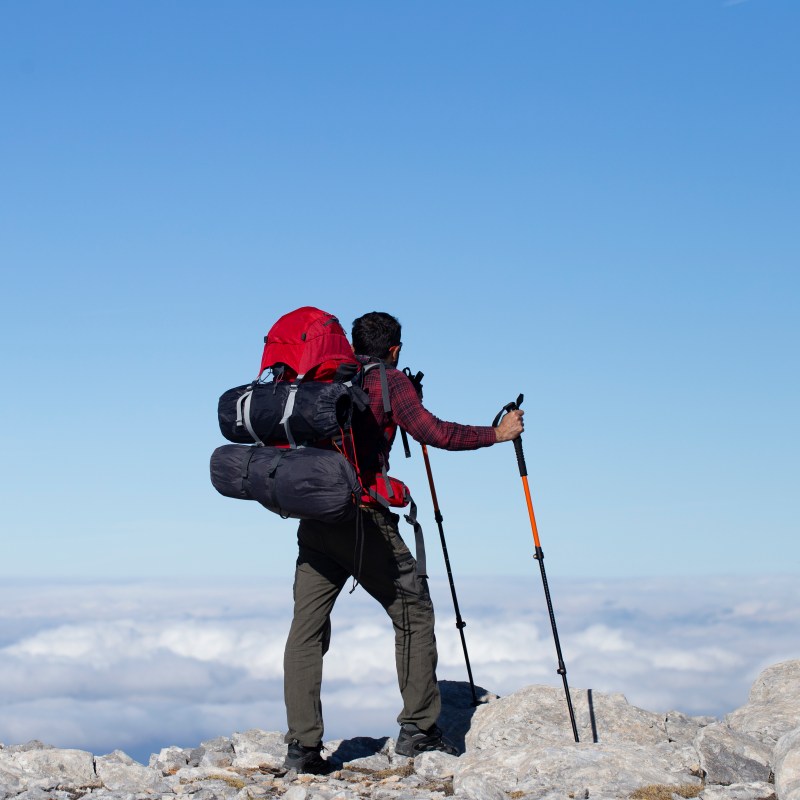
Similar to seasickness, altitude sickness can throw a wrench into what’s meant to be the trip of a lifetime.
Videos by TravelAwaits
Altitude sickness is a taxing form of oxygen starvation that’s common for hikers and climbers who ascend above 8,000 feet. The air is atmospherically ‘thinner’, meaning there’s less oxygen. Less oxygen is problematic for any mammal, but for hikers and adventurers who head above that threshold, those low oxygen levels pose even more of a threat.
The more we push our bodies to do things like scale mountains, the more oxygen our bodies need to perform optimally. It’s a vicious cycle that intensifies the higher we go.
Even those who have extensive training in mountaineering can run into headaches and nausea, or even more serious symptoms like shortness of breath and severe fatigue.
Unfortunately, there’s no quick fix to altitude sickness. Even an oxygen mask might take a few minutes to kick in for someone suffering from severe symptoms.
If you’re heading to a high-altitude zone, you might want a crash course in how to prepare for altitude sickness. First up, let’s cover where the average traveler is most likely to run into it.
Where do most travelers get altitude sickness?
The most common places for travelers to get altitude sickness are when summitting peaks like Mount Everest and Mount Kilimanjaro, along with visiting sites like Machu Picchu.
Aside from these famous sites, be mindful when you’re heading to towering mountain ranges like the Andes, the Rocky Mountains, and the Alaska Range.
You might want to look out for plateaus, as well. While the highest mountain ranges in the world border Pakistan and China (home to the Himalayas, Karakoram, and the Hindu Kush Mountains), you’re more likely to end up in Tibet.
The region’s capital of Lhasa is located at around 11,000 feet, so be mindful that even flat landscapes might be closer to heaven than they seem. Now, onto how to prepare for altitude sickness before you head out on your climb.
How to prepare for altitude sickness
Prep your body
Earlier this year, one of my friends summited Mount Kilimanjaro. One thing he wishes he had done beforehand is train with a Stairmaster—and an oxygen mask.
Devices like the Breather Fit can help train your respiratory muscles for more stressful situations. In a high-altitude case, a Breather Fit can train the lungs to manage less oxygen.
Some mountaineers also recommend training in deep breathing. Deep breathing can help you maintain the right oxygen levels as you ascend, which is particularly helpful if you’re taking a challenging, steep trail.
Learn the early signs
Altitude sickness doesn’t always look the same. Every person is likely to experience different symptoms, and at different points in time. Before you head out, consider your previous experiences in mountaineering.
What challenges did you face? When did your symptoms intensify?
The more aware you are of any potential challenges, the more readily you can make an itinerary that will work for you. And when it comes to travel and high altitudes, it might be tempting to push forward and forge ahead.
But, as we’ll see by the tips below, it’s usually better to go slow. Very slow.
Give yourself a few days to adjust before the climb
Climbers, hikers, and mountaineers all have one consistent piece of advice for fellow travelers: bake a few days into your schedule to let your body adjust.
This is before you head into high-altitude zones. The farther you travel from home, the more time your body needs to adjust to its new time zone, diet, and sleep routine.
You want your body to be healthy and ready when you start your ascent. For this reason, don’t plan on showing up and taking off. Again, slowly but surely is the key here. This is also the perfect time to start carbo-loading, as many hikers swear by carbs before heading out on a long adventure.
Plan to ascend slowly
This tip should be obvious, especially if you have experience in high-altitude adventures. But know that you shouldn’t be ascending over 1,000 feet per day.
Many experts also recommend taking a day off once you’ve notched 3,000 feet. Obviously, your pace depends on the hike and your fitness, but if you want to prevent altitude sickness, you’ll be gracious when you plan your hiking schedule.
Plan to sleep lower
Again, this might not be possible depending on your route, destination, and fitness level—but whenever possible, sleep at a lower altitude to give your body a chance to truly rest. Your body won’t magically handle less oxygen better just because you’re asleep.
Know what to avoid—and what to not avoid
Drinking and smoking are going to wreak havoc on your health at high altitudes, so it’s highly recommended that you avoid both altogether.
That being said, many hikers recommend sticking to caffeine if it’s usually part of your schedule. Not only can it help with headaches, but if you’re reliant on caffeine, now isn’t the time to send your body into withdrawal. It will only intensify symptoms of altitude sickness.
